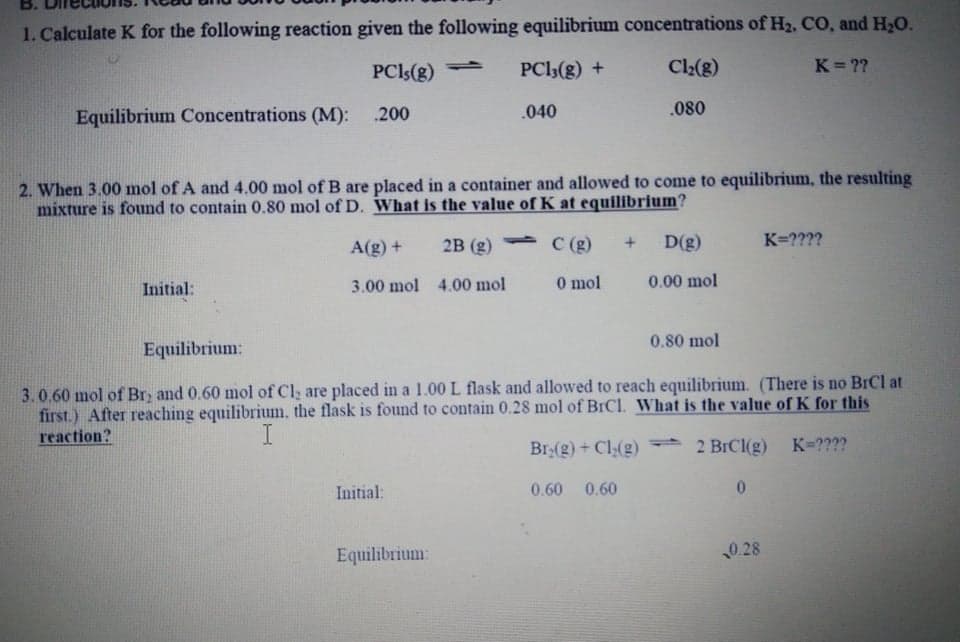1. Calculate K for the following reaction given the following equilibrium concentrations of H2, CO, and H2O. PCls(g) PCI3(g) + C2(g) K=?? Equilibrium Concentrations (M): .200 .040 .080
1. Calculate K for the following reaction given the following equilibrium concentrations of H2, CO, and H2O. PCls(g) PCI3(g) + C2(g) K=?? Equilibrium Concentrations (M): .200 .040 .080
Chemistry for Engineering Students
4th Edition
ISBN:9781337398909
Author:Lawrence S. Brown, Tom Holme
Publisher:Lawrence S. Brown, Tom Holme
Chapter12: Chemical Equilibrium
Section: Chapter Questions
Problem 12.98PAE
Related questions
Question

Transcribed Image Text:B.
1. Calculate K for the following reaction given the following equilibrium concentrations of H2, CO, and H2O.
PCI5(g)
PCI3(g) +
Cl2(g)
K ??
Equilibrium Concentrations (M): .200
.040
.080
2. When 3.00 mol of A and 4.00 mol of B are placed in a container and allowed to come to equilibrium, the resulting
mixture is found to contain 0.80 mol of D. What is the value of K at equilibrium?
A(g) +
2B (g)
1.
C (g)
D(g)
K=????
Initial:
3.00 mol 4.00 mol
O mol
0.00 mol
0.80 mol
Equilibrium:
3.0.60 mol of Br, and 0.60 mol of Cl, are placed in a 1.00 L flask and allowed to reach equilibrium. (There is no BrCl at
first.) After reaching equilibrium, the flask is found to contain 0.28 mol of BICI. What is the value of K for this
reaction?
Br:(g) + Cl(2)
2 BICI(g) K-????
Initial:
0.60 0.60
Equilibrium:
0.28
Expert Solution
This question has been solved!
Explore an expertly crafted, step-by-step solution for a thorough understanding of key concepts.
This is a popular solution!
Trending now
This is a popular solution!
Step by step
Solved in 3 steps with 4 images

Knowledge Booster
Learn more about
Need a deep-dive on the concept behind this application? Look no further. Learn more about this topic, chemistry and related others by exploring similar questions and additional content below.Recommended textbooks for you

Chemistry for Engineering Students
Chemistry
ISBN:
9781337398909
Author:
Lawrence S. Brown, Tom Holme
Publisher:
Cengage Learning

Chemistry
Chemistry
ISBN:
9781305957404
Author:
Steven S. Zumdahl, Susan A. Zumdahl, Donald J. DeCoste
Publisher:
Cengage Learning


Chemistry for Engineering Students
Chemistry
ISBN:
9781337398909
Author:
Lawrence S. Brown, Tom Holme
Publisher:
Cengage Learning

Chemistry
Chemistry
ISBN:
9781305957404
Author:
Steven S. Zumdahl, Susan A. Zumdahl, Donald J. DeCoste
Publisher:
Cengage Learning


Chemistry: An Atoms First Approach
Chemistry
ISBN:
9781305079243
Author:
Steven S. Zumdahl, Susan A. Zumdahl
Publisher:
Cengage Learning

Chemical Principles in the Laboratory
Chemistry
ISBN:
9781305264434
Author:
Emil Slowinski, Wayne C. Wolsey, Robert Rossi
Publisher:
Brooks Cole

Chemistry & Chemical Reactivity
Chemistry
ISBN:
9781133949640
Author:
John C. Kotz, Paul M. Treichel, John Townsend, David Treichel
Publisher:
Cengage Learning